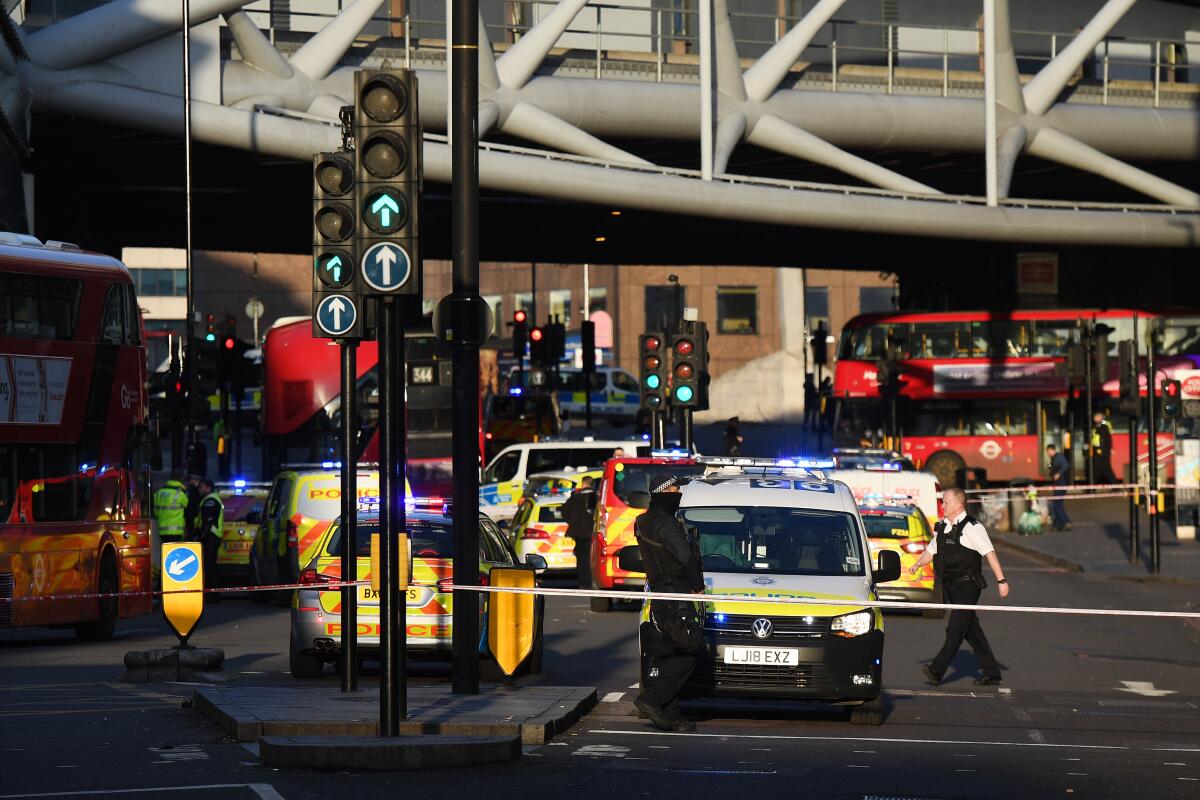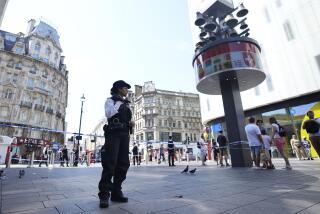Attacker in London stabbings served six years on terror charges, police say

- Share via
LONDON — A man wearing a fake explosive vest stabbed several people Friday in London, killing two of them in what police are treating as a terrorist attack. The assailant was tackled by members of the public and then fatally shot by officers on London Bridge, officials said.
Police identified the attacker as a 28-year-old who was released on probation last year after serving six years for terrorism offenses.
Hours later, an attacker stabbed three people in a busy shopping district in the Netherlands, and police were searching for the suspect, authorities said. There was no immediate indication of any link between the two incidents. A Dutch police spokeswoman said it was too early to say whether a terror motive was to blame for the attack in The Hague.
In London, Metropolitan Police Chief Cressida Dick said two stabbing victims had died and three injured people were being treated in hospitals. Health officials said one of the injured was in critical but stable condition, one was stable and the third had less serious injuries.
Police said the attacker, Usman Khan, was convicted in 2012 of terrorism offenses and released in December 2018 “on license,” which means he had to meet certain conditions or face recall to prison. Several British media outlets reported that he was wearing an electronic ankle bracelet.
Neil Basu, the London police counterterrorism head, said Khan was attending a London event hosted by Learning Together — a Cambridge University-backed program that works to educate prisoners — when he launched the attack, killing a man and a woman and injuring three others.
The attacker’s history will raise difficult questions for Britain’s government and security services. Basu said police were not actively looking for any other suspects.
Prime Minister Boris Johnson said he had “long argued” that it was a “mistake to allow serious and violent criminals to come out of prison early.”
“It is very important that we get out of that habit and that we enforce the appropriate sentences for dangerous criminals, especially for terrorists, that I think the public will want to see,” he said.
The violence erupted 2 ½ years after a van and knife attack in the same area killed eight people and less than two weeks before Britain holds a national election. The main political parties temporarily suspended campaigning in London as a mark of respect.
Basu said that the suspect appeared to be wearing a bomb vest but that it turned out to be “a hoax explosive device.”
He said officers were keeping “an open mind as to any motive.”
Dick, the police chief, said officers were called just before 2 p.m. to Fishmongers’ Hall, a conference venue at the north end of London Bridge. The pedestrian and vehicle bridge links the city’s business district with the south bank of the River Thames.
Minutes after the stabbings report, witnesses saw a man with a knife being wrestled to the ground by members of the public on the bridge before armed-response officers shot him dead.
One video posted on social media showed two men struggling on the bridge before police pulled a man in civilian clothes off a black-clad man on the ground. Gunshots followed. Another depicted a man in suit and overcoat holding a long knife that apparently had been taken from the attacker.
Other images showed police, guns drawn, pointing at a figure on the ground in the distance.
Karen Bosch, who was on a bus crossing the bridge, said she saw police “wrestling with one tall, bearded man” and then heard “gunshots, two loud pops.”
She said the man “pulled his coat back which showed that he had some sort of vest underneath, whether it’s a stab vest, or some sort of explosive vest, the police then really quickly moved backwards, away.”
Another bus passenger, Amanda Hunter, told the BBC that the vehicle “all of a sudden stopped and there was commotion and I looked out the window and I just saw these three police officers going over to a man.”
“It seemed like there was something in his hand, I’m not 100% sure, but then one of the police officers shot him.”
Police confirmed that Khan died at the scene.
London Mayor Sadiq Khan praised the “breathtaking heroism of members of the public who literally ran towards danger not knowing what confronted him.”
“They are the best of us,” Khan said.
The prime minister also praised the bystanders and said anyone who was involved in the attack “will be hunted down and will be brought to justice.”
Cars and buses on the busy bridge stood abandoned after the shooting, with a white truck stopped diagonally across the lanes. Video footage showed police pointing guns at the truck before moving to check its container.
London Bridge station, one of the city’s busiest rail hubs, was closed for several hours after the attack.
Scores of police, some armed with submachine guns, ushered office workers and tourists out of the area packed with office buildings, banks, restaurants and bars. Staff in nearby office blocks were told to stay inside.
As police cleared the streets, workers in shops and restaurants ushered customers into storerooms and basements. Some had been through similar traumatic events in June 2017, when eight people died in the van and knife attack launched by three people inspired by the Islamic State group. The attackers ran down people on the bridge, killing two, before fatally stabbing several people in nearby Borough Market.
That fatal attack took place days before a general election. Britons are due to go to the polls again Dec. 12.
Political leaders expressed shock and sorrow at Friday’s attack.
“We will not be cowed by those who threaten us,” Labour Party leader Jeremy Corbyn said. “We must and we will stand together to reject hatred and division.”
Both Labour and the Conservatives suspended campaigning in the city after the attack, and the prime minister was also canceling political events for Saturday.
Security officials this month had downgraded Britain’s terrorism threat level from “severe” to “substantial,” which means an attack is seen as “likely” rather than “highly likely.” The assessment was made by the Joint Terrorism Analysis Center, an independent expert body that evaluates intelligence, terrorist capability and intentions.
The U.K.’s terror threat was last listed as “substantial” in August 2014; since then it has held steady at “severe,” briefly rising to “critical” in May and September 2017.
The Hague attack happened about 7:45 p.m Friday, when a man stabbed several people on the street. Authorities offered no immediate motive.
“We are keeping every scenario open,” police spokeswoman Marije Kuiper said.
The stabbing happened in an area teeming with shoppers. Supermarket chains and luxury shops were lighted up with early Christmas decorations.
Police sealed off a wide perimeter behind which onlookers were kept at bay.
The Netherlands was shocked by a similar stabbing in Amsterdam a year ago, when two Americans were wounded in a knife attack that prosecutors say had a “terrorist motive.”
More to Read
Sign up for Essential California
The most important California stories and recommendations in your inbox every morning.
You may occasionally receive promotional content from the Los Angeles Times.













